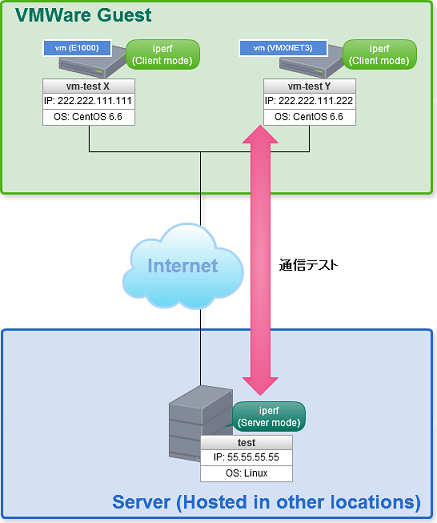VMXNET3 & E1000のパフォーマンステスト
VMware Toolsのyum installを試す関連でもうちょっと突っ込んで考えてみた。
vmxnet3とe1000でベンチマークを取ってみることに。
仮想マシンの準備
CentOS6.6 でvmxnet3とe1000のマシンをそれぞれ準備。
尚、Linux(CentOS6.6現在)に関しては、kernelにvmxnet3のドライバがすでに含まれている状態。
そのため、とりあえずvmxnet3を利用したいというだけであれば、仮想マシン作成時にNICでvmxnet3を選択してデプロイすればデフォルトでロードされる。
$ modinfo vmxnet3
filename: /lib/modules/2.6.32-504.16.2.el6.x86_64/kernel/drivers/net/vmxnet3/vmxnet3.ko
version: 1.1.30.0-k
license: GPL v2
description: VMware vmxnet3 virtual NIC driver
author: VMware, Inc.
srcversion: 502C6D11BE2EF75FC4A1B5F
alias: pci:v000015ADd000007B0sv*sd*bc*sc*i*
depends:
vermagic: 2.6.32-504.16.2.el6.x86_64 SMP mod_unload modversions
ネットワークのベンチマークを取得
今回はiperf3でネットワークのベンチマークを取得してみる。
ソースコンパイルが面倒なので、EPELから配布されているRPMを利用する。
http://dl.fedoraproject.org/pub/epel/6/x86_64/repoview/iperf3.html
EPELレポジトリの導入
レポジトリを追加する。
CentOSの場合、Extrasパッケージからレポジトリをインストールすることが可能。
$ yum list | grep epel-release.noarch
epel-release.noarch 6-8 extras
$ sudo yum install -y epel-release.noarch
追加されたことを確認。
また、今回はあくまでiperf3をインストールするためだけに導入するので、デフォルトで "enabled = 0(無効)" にしておく。
[epel]
name=Extra Packages for Enterprise Linux 6 - $basearch
# baseurl=http://download.fedoraproject.org/pub/epel/6/$basearch
mirrorlist=https://mirrors.fedoraproject.org/metalink?repo=epel-6&arch=$basearch
failovermethod=priority
enabled=0
gpgcheck=1
gpgkey=file:///etc/pki/rpm-gpg/RPM-GPG-KEY-EPEL-6
[epel-debuginfo]
name=Extra Packages for Enterprise Linux 6 - $basearch - Debug
# baseurl=http://download.fedoraproject.org/pub/epel/6/$basearch/debug
mirrorlist=https://mirrors.fedoraproject.org/metalink?repo=epel-debug-6&arch=$basearch
failovermethod=priority
enabled=0
gpgkey=file:///etc/pki/rpm-gpg/RPM-GPG-KEY-EPEL-6
gpgcheck=1
[epel-source]
name=Extra Packages for Enterprise Linux 6 - $basearch - Source
# baseurl=http://download.fedoraproject.org/pub/epel/6/SRPMS
mirrorlist=https://mirrors.fedoraproject.org/metalink?repo=epel-source-6&arch=$basearch
failovermethod=priority
enabled=0
gpgkey=file:///etc/pki/rpm-gpg/RPM-GPG-KEY-EPEL-6
gpgcheck=1
パッケージを検索
"enabled = 0" にしているレポジトリは '--enablerepo' オプションを利用すると一時的に有効にすることが可能。
$ yum list --enablerepo=epel | grep -i iperf3
iperf3.i686 3.0.10-1.el6 epel
iperf3.x86_64 3.0.10-1.el6 epel
iperf3-devel.i686 3.0.10-1.el6 epel
iperf3-devel.x86_64 3.0.10-1.el6 epel
インストール
$ sudo yum install --enablerepo=epel iperf3
ベンチマーク構成
vmxnet3とe1000の仮想マシン及び異なるロケーションにあるサーバーにそれぞれiperf3をインストール。以下のように異なるモードで動作させる。
※図中のIPアドレスはダミーアドレス。
- VM(vmxnet3/CentOS6.6) iperf Clientモード
- VM(e1000/CentOS6.6) iperf Clientモード
- サーバー(今回はAmazon EC2を使用) iperf Serverモード
iperf3の使い方
iperf2の後方互換性はないので注意が必要。
つまりiperf2がインストールされたマシンとiperf3がインストールされたマシン間の相互通信のテストが出来ない。iperfのバージョンは統一する必要がある。
基本的な使い方はiperf2も3も同じ(オプションに差異有り)
http://www.unix-power.net/linux/iperf.html
http://nextdeveloper.hatenablog.com/entry/2014/02/07/120719
実行結果
デフォルトで10秒間のトラフィックをテスト。
(※iperf Server側に出力されたレポート)
$ iperf3 -s
-----------------------------------------------------------
Server listening on 5201
-----------------------------------------------------------
Accepted connection from vm_IPADDR(E1000), port 41993
[ 5] local 172.31.6.XX port 5201 connected to vm_IPADDR(E1000) port 41994
[ ID] Interval Transfer Bandwidth
[ 5] 0.00-1.00 sec 20.9 MBytes 175 Mbits/sec
[ 5] 1.00-2.00 sec 14.9 MBytes 125 Mbits/sec
[ 5] 2.00-3.00 sec 12.4 MBytes 104 Mbits/sec
[ 5] 3.00-4.00 sec 13.6 MBytes 114 Mbits/sec
[ 5] 4.00-5.00 sec 14.3 MBytes 120 Mbits/sec
[ 5] 5.00-6.00 sec 12.6 MBytes 106 Mbits/sec
[ 5] 6.00-7.00 sec 14.5 MBytes 122 Mbits/sec
[ 5] 7.00-8.00 sec 12.0 MBytes 101 Mbits/sec
[ 5] 8.00-9.00 sec 9.32 MBytes 78.2 Mbits/sec
[ 5] 9.00-10.00 sec 10.7 MBytes 89.6 Mbits/sec
[ 5] 10.00-10.03 sec 239 KBytes 72.8 Mbits/sec
- - - - - - - - - - - - - - - - - - - - - - - - -
[ ID] Interval Transfer Bandwidth Retr
[ 5] 0.00-10.03 sec 138 MBytes 116 Mbits/sec 64 sender
[ 5] 0.00-10.03 sec 136 MBytes 113 Mbits/sec receiver
$ iperf3 -s
-----------------------------------------------------------
Server listening on 5201
-----------------------------------------------------------
Accepted connection from vm_IPADDR(VMXNET3), port 52894
[ 5] local 172.31.6.XX port 5201 connected to vm_IPADDR(VMXNET3) port 52895
[ ID] Interval Transfer Bandwidth
[ 5] 0.00-1.00 sec 27.6 MBytes 232 Mbits/sec
[ 5] 1.00-2.00 sec 15.3 MBytes 128 Mbits/sec
[ 5] 2.00-3.00 sec 16.4 MBytes 137 Mbits/sec
[ 5] 3.00-4.00 sec 14.8 MBytes 124 Mbits/sec
[ 5] 4.00-5.00 sec 15.4 MBytes 129 Mbits/sec
[ 5] 5.00-6.00 sec 15.3 MBytes 128 Mbits/sec
[ 5] 6.00-7.00 sec 13.6 MBytes 114 Mbits/sec
[ 5] 7.00-8.00 sec 15.1 MBytes 127 Mbits/sec
[ 5] 8.00-9.00 sec 16.6 MBytes 140 Mbits/sec
[ 5] 9.00-10.00 sec 10.7 MBytes 89.6 Mbits/sec
[ 5] 10.00-10.04 sec 426 KBytes 92.3 Mbits/sec
- - - - - - - - - - - - - - - - - - - - - - - - -
[ ID] Interval Transfer Bandwidth Retr
[ 5] 0.00-10.04 sec 165 MBytes 138 Mbits/sec 82 sender
[ 5] 0.00-10.04 sec 161 MBytes 135 Mbits/sec receiver
このAverageだと若干VMXNET3のほうがトラフィックが出ているようにも・・・
1分間でテストを実施した結果は下記。
(※iperf Client側に出力されたレポート)
$ iperf3 -c remoteServer_IPADDR -V -t 60 -i 10
iperf 3.0.10
Linux vm-test3 2.6.32-504.16.2.el6.x86_64 #1 SMP Wed Apr 22 06:48:29 UTC 2015 x86_64 x86_64 x86_64 GNU/Linux
Time: Fri, 01 May 2015 02:18:00 GMT
Connecting to host remoteServer_IPADDR, port 5201
Cookie: vm-test3.1430446680.734558.68d0d84b1
TCP MSS: 1448 (default)
[ 4] local vm_IPADDR(E1000) port 42001 connected to remoteServer_IPADDR port 5201
Starting Test: protocol: TCP, 1 streams, 131072 byte blocks, omitting 0 seconds, 60 second test
[ ID] Interval Transfer Bandwidth Retr Cwnd
[ 4] 0.00-10.00 sec 217 MBytes 182 Mbits/sec 54 170 KBytes
[ 4] 10.00-20.00 sec 181 MBytes 152 Mbits/sec 29 115 KBytes
[ 4] 20.00-30.00 sec 168 MBytes 141 Mbits/sec 30 122 KBytes
[ 4] 30.00-40.00 sec 181 MBytes 152 Mbits/sec 15 165 KBytes
[ 4] 40.00-50.00 sec 192 MBytes 161 Mbits/sec 31 134 KBytes
[ 4] 50.00-60.00 sec 132 MBytes 111 Mbits/sec 53 129 KBytes
- - - - - - - - - - - - - - - - - - - - - - - - -
Test Complete. Summary Results:
[ ID] Interval Transfer Bandwidth Retr
[ 4] 0.00-60.00 sec 1.05 GBytes 150 Mbits/sec 212 sender
[ 4] 0.00-60.00 sec 1.04 GBytes 149 Mbits/sec receiver
CPU Utilization: local/sender 1.0% (0.0%u/1.0%s), remote/receiver 3.5% (0.0%u/3.5%s)
iperf Done.
$ iperf3 -c remoteServer_IPADDR-V -t 60 -i 10
iperf 3.0.10
Linux vm-test4 2.6.32-504.16.2.el6.x86_64 #1 SMP Wed Apr 22 06:48:29 UTC 2015 x86_64 x86_64 x86_64 GNU/Linux
Time: Fri, 01 May 2015 02:19:18 GMT
Connecting to host remoteServer_IPADDR, port 5201
Cookie: vm-test4.1430446758.532814.39107b692
TCP MSS: 1448 (default)
[ 4] local vm_IPADDR(VMXNET3) port 52901 connected to remoteServer_IPADDR port 5201
Starting Test: protocol: TCP, 1 streams, 131072 byte blocks, omitting 0 seconds, 60 second test
[ ID] Interval Transfer Bandwidth Retr Cwnd
[ 4] 0.00-10.00 sec 158 MBytes 132 Mbits/sec 46 189 KBytes
[ 4] 10.00-20.00 sec 158 MBytes 132 Mbits/sec 23 209 KBytes
[ 4] 20.00-30.00 sec 202 MBytes 170 Mbits/sec 22 238 KBytes
[ 4] 30.00-40.00 sec 204 MBytes 171 Mbits/sec 33 219 KBytes
[ 4] 40.00-50.00 sec 179 MBytes 150 Mbits/sec 10 197 KBytes
[ 4] 50.00-60.00 sec 196 MBytes 165 Mbits/sec 15 130 KBytes
- - - - - - - - - - - - - - - - - - - - - - - - -
Test Complete. Summary Results:
[ ID] Interval Transfer Bandwidth Retr
[ 4] 0.00-60.00 sec 1.07 GBytes 153 Mbits/sec 149 sender
[ 4] 0.00-60.00 sec 1.07 GBytes 153 Mbits/sec receiver
CPU Utilization: local/sender 0.5% (0.0%u/0.5%s), remote/receiver 3.1% (0.9%u/2.2%s)
iperf Done.
1分間でAverage取るとそんなに大差ない。
同一クラスタ配下のVM同士だと問題ないけど、Externalの通信だと安定しないのが気になる(*´∩ω・`)゚+.゚
結果をふまえて
通信経路上でボトルネックになってるところあるだろうし厳密なパフォーマンスの測定にはならないが、極端な差はないので好みなんだろうな。
でもkernelに含まれているのであればvmxnet3で良い気がする。
今回はCentOS6.Xでしか比較してないので、Windows系だとまた違うかも。
